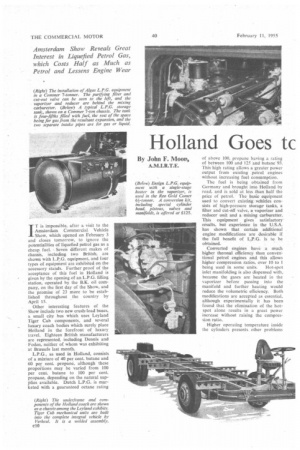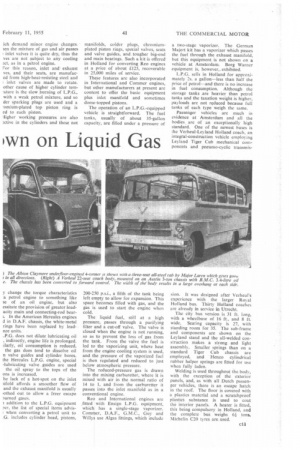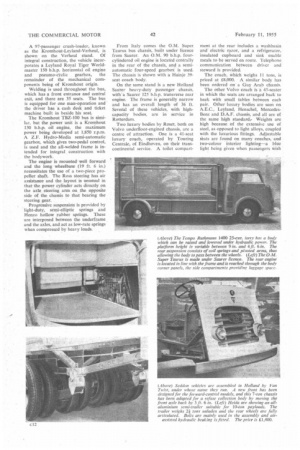Holland Goes tc
Page 50

Page 51

Page 52

Page 53

If you've noticed an error in this article please click here to report it so we can fix it.
)vvn on Liquid Gas
IT is impossible, after a visit to the Amsterdam Commercial Vehicle Show, which opened on February 3 and closes tomorrow, to ignore the potentialities of liquefied petrol gas as a cheap fuel, Seven different makes of chassis, including two British, are shown with L.P.G. equipment, and four types of equipment are exhibited on the accessory stands. Further proof of the acceptance of this fuel in Holland is given by the opening of an L.P.G. filling station, operated by the B.K. oil company, on the first day of the Show, and the promise of 23 more to be established throughout the country by April 15.
Other interesting features of the Show include two new crush-load buses, a small city bus which uses Leyland Tiger Cub components, and several luxury coach bodies which surely place Holland in the forefront of luxury travel. Eighteen British manufacturers are represented, including Dennis and Foden, neither of whom was exhibiting at Brussels last month.
L.P.G., as used in Holland, consists of a mixture of 40 per cent. butane and 60 per cent, propane, although these proportions may be varied from 100 per cent. butane to 100 per cent. propane, depending on the natural supplies available. Dutch L.P.G. is marketed with a guaranteed octane rating of above 100, propane having a rating of between 100 and 125 and butane 93. This high rating allows a greater power output from existing petrol engines without increasing fuel consumption.
The fuel is being obtained from Germany and brought into Holland by road, and is sold at less than half the price of petrol. The basic equipment used to convert existing vehicles consists of high-pressure storagetanks, a filter and cut-off valve, a vaporizer and reducer unit and a mixing carburetter. This equipment gives satisfactory. results, but experience in the U.S.A. has shown that certain additional engine modifications are desirable if the full benefit of L.P.G. is to he obtained.
Converted engines have a much higher thermal efficiency than conventional petrol engines and this allows higher compression ratios, over 10 to 1 being used in some units. Hot-spot inlet manifolding is also dispensed with, because the gases are heated in the vaporizer before passing into the manifold and further heating would reduce the volumetric efficiency. Both modifications are accepted as essential, although experimentally it has been found that the elimination of the hotspot alone results in a great power increase without raising the compression ratio.
Higher operating temperature inside the cylinders presents other problems y change the torque characteristics a petrol engine to something like se of an oil engine, but also essitatc the provision of greater loadacity main and connecting-rod bear In the American Hercules engines d in D.A.F. chassis, the white-metal rings have been replaced by leadnze units.
..PG. does not dilute lubricating oil , indirectly, engine life is prolonged. Early, oil consumption is reduced, the gas does tend to dissolve oil n valve guides and cylinder bores. the Hercules L.P.G. engine, special -lubricating valve . guides are used the oil spray to the tops of the ons is increased.
he lack of a hot-spot on the inlet iifold affords a smoother flow of and the exhaust manifold is usually :othed out to allow a freer escape lurned gases.
addition to the L.P.G. equipment Der, the list of special items advis: when converting a petrol unit to .G. includes cylinder head, pistons,
200-250 p.s.i., a fifth of the tank being left empty to allow for expansion. This space becomes filled with gas, and the gas is used to start the engine when cold.
The liquid fuel, still at a high pressure, passes through a purifying filter and a cut-off valve. The valve is closed when the engine is not running, so as to prevent the loss of gas from the tank. From the valve the fuel is led to the vaporizing unit, where heat from the engine cooling system is used, and the pressure of the vaporized fuel is then regulated and reduced to just below atmospheric pressure.
The reduced-pressure gas is drawn into the mixing carburetter, where It is mixed with air in the normal ratio of 14 to 1, and from the carburetter it passes into the inlet manifold as in a conventional engine.
Reo and International engines are fitted with Ensign L.P.G. equipment, which has a single-stage vaporizer. Commer, D.A.F., G.M.C., Guy and Willys use Algas fittings, which include sion. It was designed after Verheul's experience with the larger Royal Holland bus. Thirty Holland coaches are already in service in Utrecht.
The city bus version is 31 ft. long, with a wheelbase of 16 ft., and 8 ft. wide. Sealing capacity is 27, with standing room for 35. The sub-frame and components are shown on the Leyland stand and the all-welded construction makes a strong and light assembly. Smaller springs than on a standard Tiger Cub chassis are employed, and Henzo cylindrical rubber helper springs are fitted for use when fully laden.
Welding is used throughout the body, with the exception of the exterior panels, and, as with all Dutch passenger vehicles, there is an escape hatch in the rod. The floor is covered with a plastics material and a scratchproof plastics substance is used to coat the interior panels. A heater is fitted, this being compulsory in Holland, and the complete bus weighs 61 tons. Michelin C20 tyres are used.
A 97-passenger crush-loader, known as the Kromhout-Leyland-Verheul, is shown on the Verheul stand. Of integral construction, the vehicle incorporates a Leyland Royal Tiger Worldmaster 150 b.h.p. horizontal oil engine and pneumo-cyclic gearbox, the remainder af the mechanical components being of Kromhout
Welding is used throughout the bus, which has a front entrance and central exit, and there are 35 seats. The bus is equipped for one man-operation and the driver has a cash desk and ticket machine built in beside his seat.
TheKromhout TBZ-100 bus is similar, but the power unit is a Krornhout 130 b.h.p. oil engine, the maximum power being developed at 1,850 r.p.m. A Z.F, Hydro-Media semi-automatic gearbox, which gives two-pedal control, is used and the all-welded frame is intended for integral construction with the bodywork.
The engine is mounted well forward and the long wheelbase (19 ft. 6 in.) necessitates the use of a two-piece propeller shaft. The Ross steering has air assistance and the layout is unusual in that the power cylinder acts directly on the axle steering arm on the opposite side of the chassis to that bearing the steering gear.
Progressive suspension is provided by light-duty, semi-elliptic springs and Henzo hollow rubber springs. These are interposed between the underframe and the axles, and act as low-rate springs when compressed by heavy loads. From Italy comes the 0.M. Super Taurus bus chassis, built under licence from Saurer. An O.M. 90 b.h.p. fourcylindered oil engine is located centrally in the rear of the chassis, and a semiautomatic four-speed gearbox is used. The chassis is shown with a Hainje 3seat coach body.
On the same stand is a new Holland Saurer heavy-duty passenger chassis, with a Saurer 125 b.h.p. transverse rear engine. The frame is generally narrow and has an overall length of 36 ft. Several of these vehicles, with highcapacity bodies, are in service in Rotterdam.
Two luxury bodies by Roset, both on Volvo underfloor-engined chassis, are a centre of attraction. One is a 41-seat luxury coach, operated by Touring Centrale, of Eindhoven, on their transcontinental service. A toilet compact
merit at the rear includes a washbasin and electric razor, and a refrigerator, insulated cupboard and sink enable meals to be served en route. Telephone communication between driver and steward is provided.
The coach, which weighs El tons, is priced at £8,000. A similar body has been ordered on a Guy Arab chassis.
The other Volvo coach is a 45-seater in which the seats are arranged back to back with small tables between each pair. Other luxury bodies are seen on A.E.C., Leyland, Henschel, MercedesBenz and D.A.F. chassis, and all are of the same high standard, Weights are high because of the extensive use of steel, as opposed to light alloys, coupled with the luxurious fittings. Adjustable seats are found on many coaches, and two-colour interior lighting—a blue light being given when passengers Wish
leep—a sensible and inexpensive liC.
Henschel chassis with transversely nted engine at the front is shown a 64-passenger bus body by Rijk. is a " balconk-type " rear entrance, sund on trams, which should cut loading time. Seats are provided l0 persons.
le Bussing 4,500 coach chassis is n with a lengthened wheelbase, mg it suitable for 42-seat bodies. is a special adaptation for Ifolland and the frame has been extended by 18 in. just " behind the rear-engine mountings.
The heaviest goods vehicle on. show is a Thomyeroft Mighty Antar tractor, Which is seen with a ScammelI Constructor 6 x 6 on the Sieherg stand. A Guy Goliath bears a notice to the effect that the name has been changed to Invincible. Other British heavies include A.E.C., Leyland and Albion chassis.
A new six-wheeler of 23-ton gross rating is displayed by Kromhout. This
has a 16-ton bogie loading, the Dutch weight restriction being 8 tons per axle outside the main cities. The chassis has full forward control and air-assisted steering, and it is powered by a Kromhout 130 b.h.p. engine with Z.F. six-speed synchromesh gearbox. The bogie is built by Kirkstall and the robustness of the transmission can be gauged from the use of Hardy Spicer 1.700 universal joints on the propeller shafts. A mechanically operated exhaust obturator augments the Westinghouse air-braking system.
The Magirus Deutz 74-ton chassis is now offered as -a forward-control unit. One is shown with a modern-styled cab built specially at the Magirus plant in Holland, and all-round visibility is a strong point.
There is a possibility that the Deutz V-12 265 b.h.p. air-cooled engine will shortly be fitted to a heavy-duty sixwheeled chassis. At the moment this engine is used only in military vehicles.
D.A.F. have redesigned their front
and rear axles to allow greater payload capacities, and a new 4 x 4 of 10-ton gross rating, powered by a Perkins. P6 oil engine, is shown. All D.A.F. chassis are of welded construction and have sliding supports, instead of shackles, at the rear of the road springs.
An interesting road sweeper shown by Netam employs the vacuum-cleaner principle, in addition to rotating brushes, and the engine-driven fan has a capacity of 600 cu. yd. per hour. The dust is drawn into a 4-cu.-yd tipping body and passes through a water spray. The tailboard is rubber-sealed and operated by compressed-air rams.
Netam also show an all-alloy threeway tipper with an alloy sub-frame. Sub-frame and body weigh 17 cwt.
A Geesink airport. runway sweeper has two folding arms carrying rotating brushes which, when lowered, enable the sweeper to clean a path 27 ft. wide.
Heida have built a light-alloy 10-ton semi-trailer with an eight-wheeled rear axle. It weighs 21 tons. The underframe consists of special extruded sections with deep flat plates, the whole forming an elongated I section. It is mainly a bolted assembly, although the corrugated floor plates are rive'ted, and sells for £1,400.
















































































































